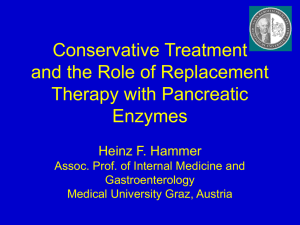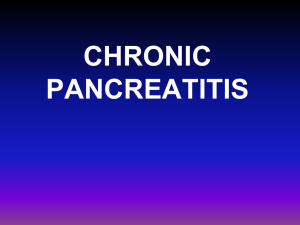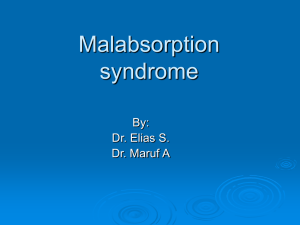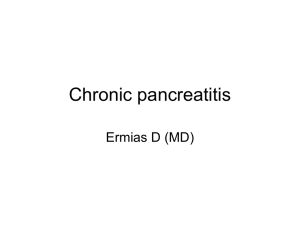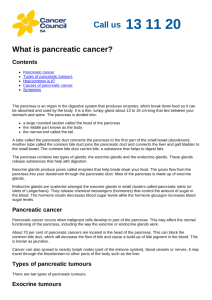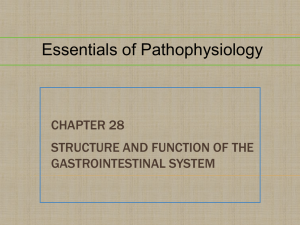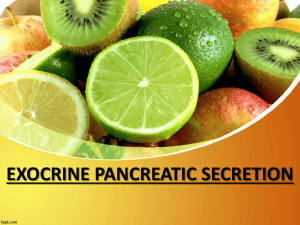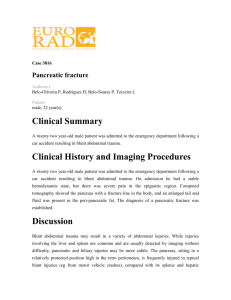A11 Tytgat (type , size 1.24 MB)
advertisement
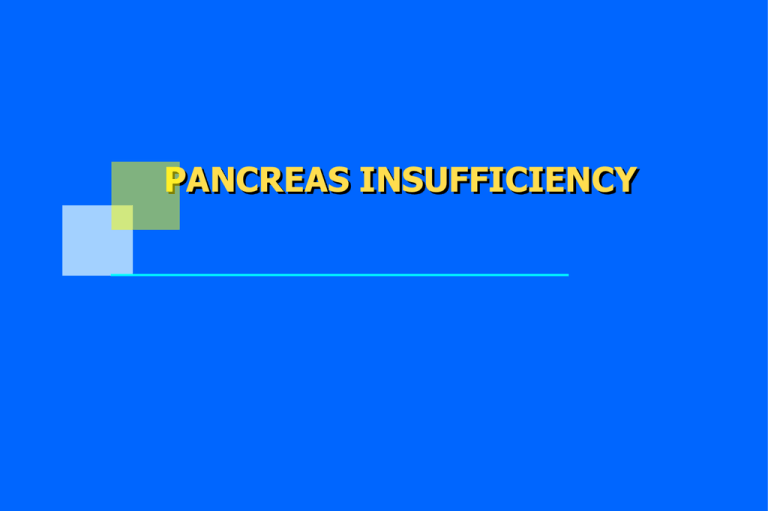
PANCREAS INSUFFICIENCY Lipase Micelles Bile acids (Conc. >CMC) Fatty acid or monoglyceride Polar end of bile acid Hydroxyl groups of bile acids Bile acid HUMAN PANCREATIC LIPASE Interfacial enzyme,active in the lipidwater interface Dependent on clean interface for lipolysis Colipase binds to lipase in presence of bile salts Lipase is specific for primary esterbond Lipase is rapidly and irreversibly inactivated at pH<4 Chylomicron Formation and Secretion FA and MG Uptake from micellar solution Mitochondria Esterification Granularendoplasmicreticulum Surface stabilization Chylomicron formation Addition of lipoprotein Nucleus Secretion via intercellular spaces into lacteals Golgi material Pancreatic Exocrine Function Normal post-prandial pancreatic secretion is ±70% of maximal secretory capacity or 4–5 times the basal rate Post-prandial secretion lasts for about 4 hours Total intraduodenal lipase output varies from 300,000 to 500,000 U/meal Minimum pancreatic function of 10% of normal is necessary for adequate lipid digestion, corresponding to ± 30,000–50,000 U lipase in the duodenum Amount of lipase, to be added to meals, varies depending upon degree in insufficiency and degree of gastric/duodenal denaturation Pancreatic Exocrine Insufficiency Steatorrhea (mild:7–10 g/d; moderate: 10–20 g/d; severe: >20 g/d) Bile salt precipitation due to low duodenal pH (bicarbonate deficiency)→increased fecal bile salt loss Impaired CCK and GIP release→sluggish gallbladder emptying Malabsorption of lipid-soluble vitamins,cholesterol SYMPTOMATOLOGY OF EXOCRINE PANCREATIC INSUFFICIENCY Steatorrhea and creatorrhea causes -Abdominal complaints bloating,pain,cramps urgency,diarrhea,foul smelling stools -Generalised symptoms - weight loss fatigue,loss of energy sympoms related to vitamin deficiencies - - Exocrine Pancreatic Insufficiency Diagnosis • Suspicion because of associated medical condition and: clinical history of steatorrhea weight loss • Laboratory tests fat balance test (not specific) non-invasive pancreatic function test • fecal elastase, fecal chymotrypsin, PABA test invasive direct pancreatic function test (gold standard) • secretin test Indications for Pancreatic Enzyme Therapy Exocrine pancreatic insufficiency causing – any moderate / severe steatorrhea – any steatorrhea with weight loss – chronic / watery diarrhea – dyspeptic symptoms Unrelenting pain in chronic pancreatitis (inhibition of pancreatic secretory drive by negative feedback) (non-enteric coated preparations) Pancreatic Enzyme Preparations Non-Enteric Coated Preparations Pancreatin powder / granulate blends well with food unpalatable denaturation in acid / peptic milieu hyperuricosuria Pancreatin tablet / capsule inadequate dispersion into the meal neutral taste denaturation in acid / peptic milieu Pancreatic Enzyme Preparations Enteric Coated Preparations Enteric-coated tablet / capsule (dissolving at pH >5) prolonged gastric retention causing de-synchronisation failed or delayed dissolution when duodenal pH is low (lack of bicarbonate) Enteric-coated microspheres (dissolving at pH >5) premature gastric dissolution when pH >5 during early phase of meal delayed gastric emptying of particles >1.4 mm failed or delayed dissolution when duodenal pH is low Enteric Coated Mini-Doses Preparation Galenic aspects gelatin capsule pH dependent enteric coated layer pancreatin Microsphere Pancreatic Enzyme Preparations Lipase Amylase Protease sphere diam. Creon 8,000 9,000 450 1.4 (1.2–1.7) Pancrease 5,000 2,900 330 2.0 (1.7–2.2) Panzytrat 25,000 22,500 1,250 2.0 Creon forte 25,000 18,000 1,000 1.4 (1.2–1.8) microspheres larger than 1.4 mm empty more slowly than solid phase of the meal release of enzymes from microspheres is slow, depending upon pH and ionic strength of medium Pancreatic Enzyme Preparations Course of dissolution of enteric oat 100 90 80 70 60 50 40 30 20 10 0 Creon Creon Forte Pancrease Pancrease HL Panzytrat 5,0 5.2 5.4 5.6 5.8 6.0 Pancreatic Enzyme Preparations Dosage recommendations • Enzyme supplementation during all meals • Main meal: 25.000 to 75.000 FIP units lipase of EC preparation • In-between snacks: 5.000 to 25.000 FIP lipase of EC preparation • Dosage should be adjusted for individual patient • Addition of H2-receptor blocker or protonpump inhibitor Pancreatic Exocrine Insufficiency Dietary recommendations Abstinence from alcohol In principle NO limitation of fat content of food (<60 g/d) (unpalatable; risk of deficit of essential fatty acids e.g. linoleic acid) except therapy failure Frequent small meals Reduction in fiber content (fiber inhibits pancreatic enzymes) Medium chain triglycerides (C6-C12) (80–120 g/d) in case of insufficiently corrected steatorrhea and weight loss Therapy of Pancreatic Insufficiency Treatment failure • Acid related – inactivation of lipase – precipitation of bile salts – enteric coat dissolves too distally • Related to the use of medication – too low dose – noncompliance – incorrect timing or mode of ingestion • False diagnosis or concomitant disease – celiac disease – bacterial overgrowth
